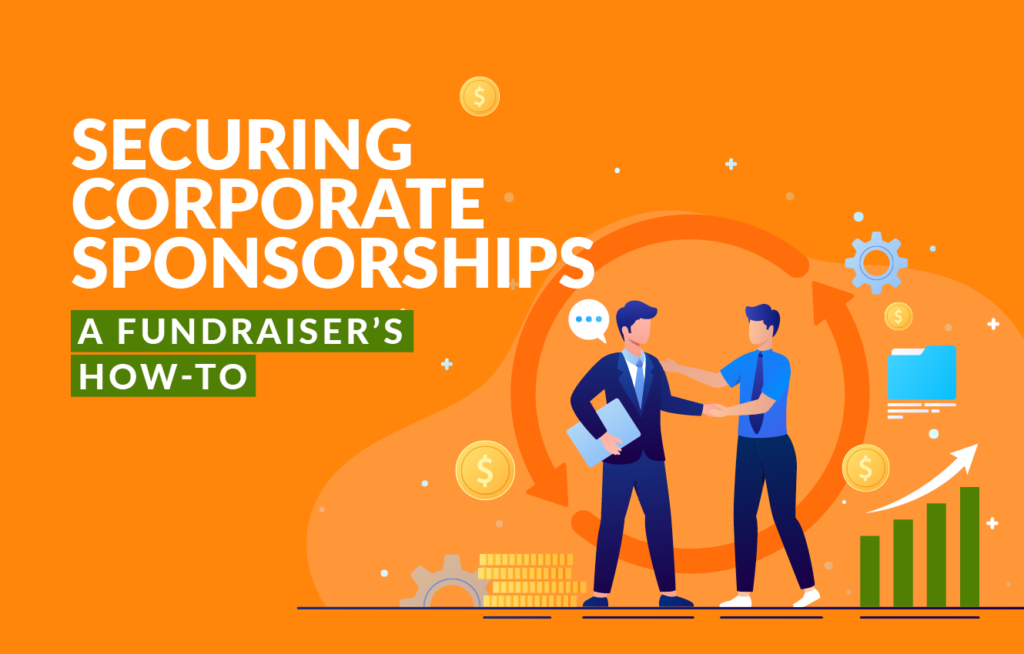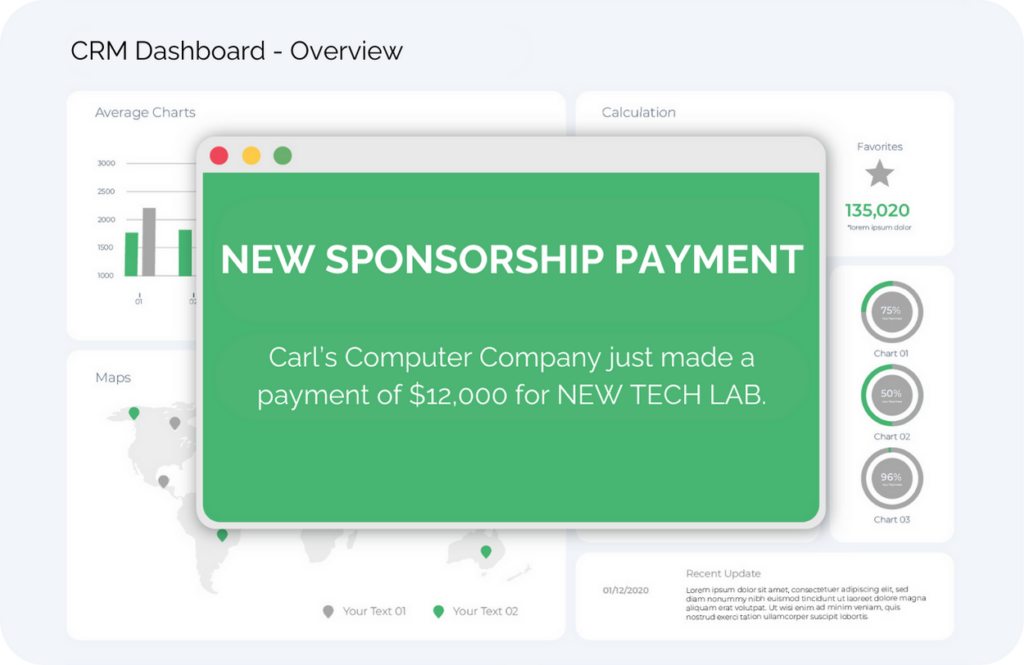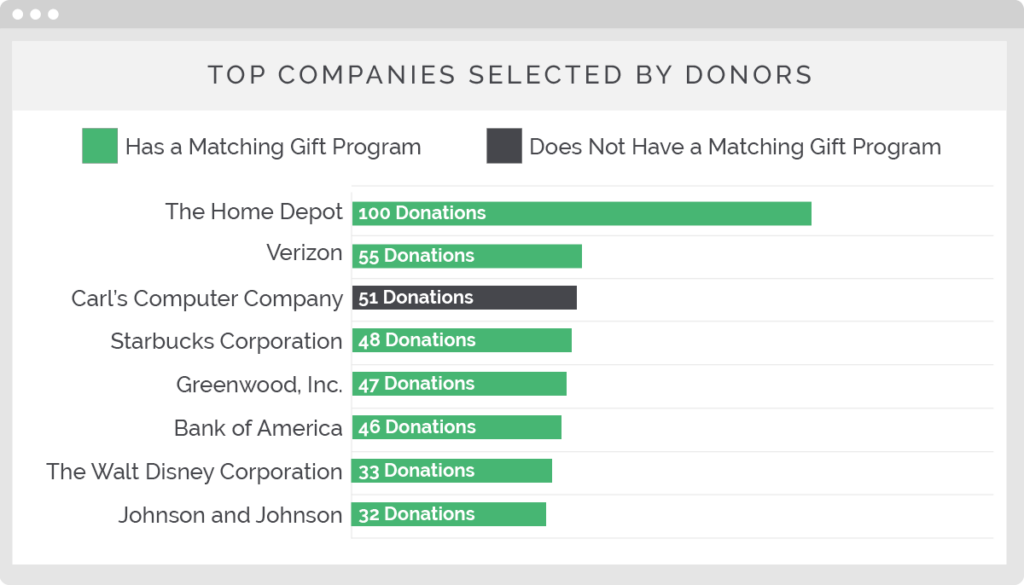
Nonprofit organizations and businesses can have a lot in common. Luckily, with corporate philanthropy trending positively for businesses everywhere, companies are more excited than ever to support charitable causes like yours. Not to mention, securing corporate sponsorships supplies your nonprofit with a significant fundraising boost.
However, to access those corporate dollars and form mutually beneficial partnerships with businesses, you have to seek out sponsorship agreements strategically.
In this guide, we’ll cover the basics of corporate sponsorships and share key steps you can take to secure them. These include:
- Step #1: Selecting the right program or event.
- Step #2: Researching high-potential prospects.
- Step #3: Drafting a proposal and reaching out.
- Step #4: Making your sponsorship pitch.
- Step #5: Calling to follow up.
- Bonus: Best Resources for Effectively Securing Corporate Sponsorships
The more you know about securing corporate sponsorships, the more likely you are to identify and pursue the best opportunities for your team. Let’s dive in.
What is a Corporate Sponsorship?
According to Double the Donation’s guide on the topic,
Corporate sponsorship refers to financial or in-kind support that businesses provide nonprofits. While the funds are generally designated to a specific event, program, or project, corporate sponsorships can take many different forms.
These include:

Employee giving sponsorships
You might think of employee or workplace giving as a cross between a corporate sponsorship and an individual donation. These types of initiatives, which include popular programs such as matching gifts, volunteer grants, and more, involve directly engaging with a company’s employees. And when an employee supports your organization with their time or money, the company supplies additional funding in response.
Event sponsorships
When most organizations think of sponsorships, they think of a company sponsoring a nonprofit event in exchange for advertising. If a pet supply store sponsored your animal shelter’s 5K, for instance, they might cover all the event’s costs if you include their name and logo in your marketing materials. Meanwhile, sponsorships for tabled events or auctions often come with a certain number of tickets for the business to distribute to employees or other members of their community.
Marketing sponsorships
Some businesses support nonprofits by supplying additional marketing exposure for their cause. As part of Google’s corporate giving program, for example, the company provides eligible nonprofits with $10,000 worth of monthly advertising grants they can use to promote their organization on the search engine. At the same time, other cause marketing efforts might involve a company gifting a portion of revenue derived from product sales!
Financial sponsorships
Any sizable corporate donation to your nonprofit can be considered a financial sponsorship. However, most sponsorship funding is gifted with a specific project or program in mind. Whether a business contributes funds for new equipment or funds the kickoff of a new initiative, companies can provide valuable resources for a charitable cause and receive positive publicity in return.
In-kind sponsorships
Rather than providing financial support to your nonprofit, a company might donate tangible goods or services instead. This could look like a restaurant owner letting you use their venue space at no cost, a law firm donating pro bono legal services, a grocer contributing food and beverage supplies for an upcoming event, or just about any business supplying auction item donations.
Regardless of the type of sponsorship your organization is looking for, the following steps and strategies will help you secure the corporate support you need to make an impact.
1. Select the right program or event.
The first step in the process involves selecting the particular project, program, or event for which your team is seeking sponsorship. For the best results, the initiative you pitch should be relevant to the prospective company’s own mission and vision.
For example, you might want to pitch a healthy eating program to your local Starbucks, while asking a Chuck E. Cheese center to sponsor a youth summer camp.
Why? Corporations want to sponsor programs that align with a cause that matches their desired image. Thus, it’s critical to align the corporate mission and specific marketing demographic with your own cause.
Not to mention, corporate sponsors also want a lot of exposure. When choosing the program for which to request a sponsorship, try focusing on a large-scale event that will have a good amount of publicity. Not to mention, you’ll want to consider the width of your event reach. Look for an upcoming program that will be marketed to your community, to an entire region, or even across the globe.
Galas, video projects, or, event-a-thons can make excellent choices.
2. Research high-potential prospects.
It’s time to start drafting a list of companies to which you’d consider pitching a sponsorship. This should include companies with…
- Existing connections to your nonprofit (think: donors’ employers, board members’ contacts, etc.)
- A history of supporting your organization through other giving initiatives, such as matching gifts or volunteer grants
- Corporate foundations and/or formal sponsorship request processes (hint: be sure to follow it if so!)
- Proven records of supporting nonprofit causes, specifically through corporate sponsorships
- A vision or mission that aligns with your organization’s own
The best prospects are going to be the businesses where the support they have to give matches the support you’re looking for. You can always come back to prospects in the future if your needs change.
3. Drafting a proposal and reaching out.
As you begin initiating outreach, note the most appropriate contacts for each potential sponsor. For example, some companies’ philanthropy will be managed by the “Community Relations Manager,” while others may directly involve the business’s CEO or President. Local corporations may even have employee-led fundraising committees that triage and select corporate sponsorship recipients. If the best contact isn’t obvious, contact someone who is likely to know who it is—such as an Operations Manager or HR head.
When reaching out, aim for a face-to-face meeting, or at least have a productive phone conversation to sell your program and discover the best method for requesting funds. Keep in mind that if you have an existing connection (e.g., a major donor works for the business), you may want to ask the individual to facilitate a warm introduction for your cause.
Either way, be sure your team has a sponsorship proposal package ready to personalize and send to corporate contacts immediately after a meeting. A solid proposal should include an overview of…
- Benefits the business will receive, such as advertising exposure, at specific levels of giving.
- A brief but powerful and confident statement of nonprofit impact and history.
- A thorough examination of how the opportunity connects to the corporation’s primary marketing demographic and stated corporate social responsibility strategy.
- Visually appealing pictures, graphics, letterhead, and overall professional presentation.
For example, check out the following proposal:
$10,000 Eagle Sponsors receive their corporate name on the Top Educator award, along with a table for 6 executives at our annual Gala dinner for 500 of the City’s top education executives. Their name will also be connected to the event as an Eagle Sponsor on our press release and Fox newscast to reach up to 300,000 local viewers. Award winners receive an interview with the local PBS radio station, where the Eagle Sponsor will again be mentioned. The awards and their sponsors are posted for a year on our website and Facebook page, with 75,000 hits annually and 20,000 friends, respectively.
4. Make your sponsorship pitch.
When it comes to actually pitching your sponsorship opportunity, email is typically the most effective communication channel. This means you want to send your proposal as a simple, easy-to-download PDF file to maintain the document’s widespread accessibility.
Additionally, make sure you include a direct, powerful, and summative cover email with the attachment. You’ll want to introduce yourself, include your contact information, and provide a one-sentence summary of the proposal.
Realistically, a lot of emails go unread. It’s important to take steps that ensure yours is easily digestible and focuses on only the most important parts of your message.
Top tip: You may have to send the proposal more than once or follow up with a receipt of proposal email without an attachment to ensure it doesn’t get caught in SPAM filters.
5. Call to follow up.
Within a week or two following your mailed or emailed proposal, you’ll want to give your point of contact another call to follow up about the opportunity. If the contact wants to reject your pitch, try requesting a meeting or inviting the contact to visit your offices to renegotiate a different sponsorship concept.
Once a company has expressed interest in your cause, even by speaking with your team about the partnership opportunity, it means you have your foot in the door. Continue to follow up and engage with the contact with persistence, adjusting your sales pitch until you find the perfect angle.
Bonus: Best Resources for Effectively Securing Corporate Sponsorships
Successful corporate sponsorships are more attainable than ever before. This is especially true when you equip your team with the tools and resources they need to identify, pitch, and maintain relationships with corporate partners in the long run.
Check out these recommended solutions, and consider how each might impact your own organization’s corporate fundraising.
Robust Constituent Relationship Management (CRM) Software
First, you’ll want to ensure your team is equipped with a robust CRM tool to manage your corporate relationships effectively and efficiently. Although the specific features will vary from one system to the next, this type of solution will generally allow you to…
- Manage contact information and communication preferences for prospective companies’ decision-makers
- Add and review notes on past interactions and partnership conversations (including emails, phone calls, meetings, and events)
- Track previous contributions and pledged sponsorship amounts
- Access robust reporting options to communicate sponsorship impact

Remember: an organized and well-thought-out pitch is likely going to make a significantly more positive impact than a haphazardly managed effort. Fortunately, the information collected and stored in your donor management system can go a long way in communicating your team’s consideration for the prospect’s time and objectives.
Make sure your CRM integrates with your team’s other tools and resources, too. For example, you’ll want to connect your donor management tool with your matching gift software and other leading solutions!
360MatchPro’s Top Companies Tool
Next up, 360MatchPro by Double the Donation is the industry’s leading matching gift automation tool. To aid organizations in growing matching gift revenue, the platform collects employment information from donors as they give and provides donors with a direct link to their employer matching gift forms.
If your team utilizes Double the Donation, the employment data it sources can be one of your organization’s most valuable resources when it comes to locating top corporate partnership prospects!
In fact, the “Top Companies Selected By Donors” tool (pictured below) is designed to highlight the employers that are most prominent in your donor base.

From there, your team can use the provided insights to inform your sponsorship outreach efforts. For example, you might pitch a partnership opportunity to the leading matching gift companies in your database. You already know your audiences have a lot in common (your donors = their employees), and they’ve shown an existing interest in corporate philanthropy through their matching gift programs.
However, another option is to target the companies your donors work for that do not match employee gifts. Let these companies know their employees are invested in your cause, and demonstrate how a proposed sponsorship is an excellent opportunity to grow their philanthropic efforts.
Customizable Corporate Sponsorship Proposal Template
Drafting a sponsorship proposal can be overwhelming, especially if you don’t know where to start. That’s why we’re providing a free, customizable template here!
[Nonprofit Logo]
[Nonprofit Name]
[Address]
[City, State, ZIP Code]
[Phone Number]
[Email Address]
[Website][Date]
[Corporate Sponsor’s Name]
[Corporate Sponsor’s Address]
[City, State, ZIP Code]Dear [specific member of a prospective sponsor’s team],
[Opening Paragraph]
We are reaching out to you on behalf of [Nonprofit], a [brief description of the organization’s mission and activities]. We are excited to present you with an exclusive opportunity to partner with us and support our cause.
[Mention of Audience Overlap]
The [Nonprofit] team believes that your company would make an excellent fit for our sponsorship program. One of the biggest reasons is the existing overlap between your workforce and our donors! In fact, in the last year, our organization received generous donations from # of employees totalling more than $[sum of employee donations].
[Sponsorship Benefits]
By becoming a sponsor of [Event/Program Name], [Corporate Sponsor’s Name] will receive a range of benefits, including but not limited to:
- Brand visibility: [Specify where and how the sponsor’s brand will be displayed or mentioned during the event/program. This could include logos on promotional materials, banners, social media mentions, program communications, press releases, and more]
- Employee engagement: [Determine whether your intended sponsorship involves opportunities for direct employee engagement. If so, communicate this aspect of your plan and outline how the prospective partner’s staff will be involved. Don’t forget to mention the benefits of doing so, such as increased productivity, longer tenures, and other positive outcomes.]
- Networking opportunities: [Highlight opportunities for the sponsor to connect with key stakeholders, attendees, or other corporate partners. This might include VIP receptions, speaking opportunities, or exclusive meetings.]
- Corporate social responsibility: [Explain how sponsoring this event/program aligns with the sponsor’s CSR goals and values. Highlight the positive impact their support will have on your cause or community.]
[About the Event/Program]
We’d love to have your company and its employees involved in our upcoming event. [Describe the event or program for which you are seeking sponsorship. Highlight its significance, past success, and anticipated impact. Include relevant details such as date, location, expected attendance, and any media coverage.]
[Sponsorship Levels]
We offer several sponsorship levels to accommodate a range of budgetary considerations. Each level comes with its own set of benefits and opportunities, so we encourage you to read the attached sponsorship package for more detailed information.
[Call to Action]
We invite you to join us in making a meaningful difference in the lives of [describe the beneficiaries or community impacted by the organization’s work].
[Closing]
We are eager to discuss how we can tailor a sponsorship package to meet your specific needs and objectives. Please contact [Name, Title] at [Phone Number] or [Email Address] to further discuss the partnership opportunity.
Thank you for your consideration, and we look forward to the possibility of working together to create positive change.
Sincerely,
[Your Name]
[Your Title]
[Nonprofit Organization Name]
Feel free to tailor these sample pitches to fit the specific circumstances of your organization and the prospective sponsor you’re approaching. Companies are going to respond more positively to a proposal that was clearly crafted with their businesses in mind.
Wrapping Up
Securing corporate sponsorships is a vital aspect of fundraising for many nonprofits, significantly elevating an organization’s reach and impact. However, mastering the art of sponsorship identification, acquisition, and maintenance can sometimes prove to be a challenge.
By following the strategies outlined in this guide, organizations like yours can cultivate long-lasting relationships built on mutual benefit and shared values.
Remember, securing corporate sponsorships is not just about receiving financial support. It’s about forging meaningful partnerships that extend beyond monetary transactions.
As a result, it’s essential to approach sponsorship opportunities with creativity, persistence, and professionalism. Be proactive in your outreach efforts, striving to understand the needs and motivations of potential sponsors. And above all, be genuine in your interactions, fostering relationships based on trust, transparency, and shared purpose.
Read now: Matching Gifts and Matching Grants | Double the Impact!


